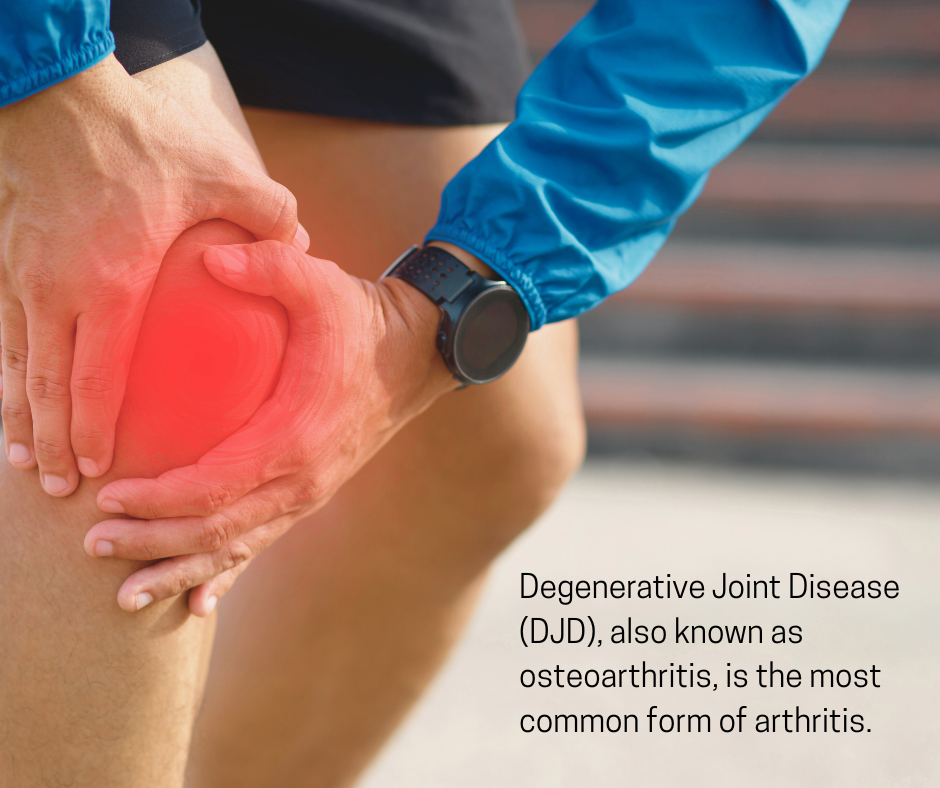Understanding Degenerative Joint Disease: Causes, Symptoms, and Treatment

Did you know that arthritis is actually Degenerative Joint Disease (DJD)?
What are the causes of DJD?
Degenerative Joint Disease (DJD), also known as osteoarthritis, is the most common form of arthritis. It affects millions of people worldwide, particularly those over the age of 50. This progressive condition involves the breakdown of cartilage, the protective tissue that cushions the ends of bones within the joints. As the cartilage wears away, bones may begin to rub against each other, leading to pain, stiffness, and reduced mobility.
In this article, we’ll explore the causes and symptoms of DJD, as well as treatment options.
Causes of Degenerative Joint Disease
Degenerative Joint Disease can develop due to a combination of factors, including:
- Aging: Cartilage naturally deteriorates with age.
- Joint Overuse: Repetitive motion or long-term physical stress on joints, such as from manual labor or sports, can accelerate cartilage breakdown.
- Injury: Previous joint injuries or trauma (e.g. fractures or ligament tears) increase the risk of DJD.
- Obesity: Excess body weight puts added stress on weight-bearing joints like the knees, hips, and spine.
- Genetics: A family history of osteoarthritis can increase susceptibility.
- Poor Posture or Biomechanics: Misaligned joints and abnormal movement patterns can hasten joint wear.
Common Symptoms of Degenerative Joint Disease
Symptoms can range from mild to severe and often worsen over time. Common signs include:
- Joint Pain: Often worsens with activity and improves with rest
- Stiffness: Especially noticeable after periods of inactivity or in the morning.
- Swelling: Due to inflammation in and around the joint.
- Reduced Range of Motion: Affected joints may feel tight or difficult to move.
- Grinding Sensation: You might feel or hear cracking or popping when moving the joint.
Treatment Options for DJD
While DJD is a chronic condition with no known cure, various treatments can manage symptoms, slow progression, and improve quality of life. These include:
- Medications
- Over-the-counter pain relievers (e.g., acetaminophen, NSAIDs).
- Prescription medications for more advanced cases.
- Topical creams or gels.
- Physical Therapy
- Exercises to strengthen muscles around the joint and improve flexibility.
- Stretching techniques to enhance mobility.
- Lifestyle Modifications
- Weight management to reduce joint stress.
- Low-impact exercise (e.g. swimming, walking, yoga).
- Joint protection strategies and ergonomic adjustments.
- Surgery
- Joint replacement or repair may be considered in severe cases.
Chiropractic Care for Degenerative Joint Disease
Chiropractic treatment is a non-invasive, drug-free option that can play a significant role in managing DJD. Chiropractors focus on spinal and joint alignment, which helps improve movement patterns, reduce pain, and support overall joint function.
Benefits of Chiropractic Care for DJD Include:
- Pain Relief: Gentle adjustments can help reduce joint pressure and nerve irritation, easing discomfort.
- Improved Joint Mobility: Restoring proper joint alignment enhances range of motion and flexibility.
- Decreased Inflammation: Chiropractic care may help lower inflammation in and around the joints.
- Enhanced Posture and Balance: Proper alignment supports better biomechanics, helping to reduce wear on affected joints.
Start Feeling Better with an Ann Arbor Chiropractor
Chiropractic work can help you manage degenerative disc disease, as well as many other secondary conditions. To get started with an Ann Arbor Chiropractor, schedule a no-commitment consultation by calling 734-221-0362 or submitting a contact form here.






